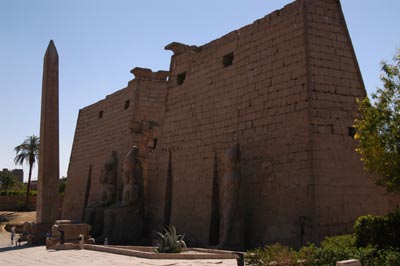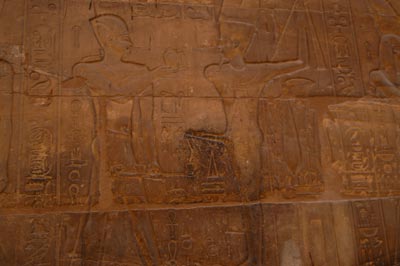










more photos
site details
0700-2100 winter
0700-2200 summer
0800-1100, 2000-2300
ramadan
E£20 entry
camera free
relevant links
Temple of Luxor

Luxor Temple sits in the middle of Luxor, only a few blocks down from our hotel and an easy walk from the curved corniche and its restaurants and stalls. The temple is dedicated to the Theban triad -- Amun-Min, Mut, and Khonsu -- as are many of the temples and monuments in Luxor.
Unlike the Temple of Karnak, which was built by many pharaohs over the course of many dynasties, Luxor was built by two pharaohs in the New Kingdom. Luxor was founded by Amenophis III in the 18th Dynasty. His son, who becamse the heretic pharaoh Akhenaton, abandoned the project for his temple in Amarna, added a sanctuary to Aten alongside the temple. Then, Ramesses II added the colonnaded court and great pylon.

Of course, other pharaohs added bits and pieces to the temple -- including major renovations by ALexander the Great -- over the course of the centuries. But, Luxor Temple seems more..homogenous than the enormous collection of buildings at the Temple of Karnak.
The temple was buried in sand until very recently, and the city of Luxor grew over the ruins. Many of the releifs are in good condition because of the sand covering them for so many years. The great courts were used for storage, houses were built in the halls, and even a colorful mosque was built on top of the remains of one of the pylongs.
Early photos of the temple show a muddle of stone blocks and ruined buildings. THe restoration work here has been impressive.
Just inside of the entrance is a mud-brick roman chapel and then the courtyard opens to a line of sphinxes that would have connected this temple with that of Karnak. Unlike the ram-headed sphinxes at Karnak, these had human faces. We got to see quite a bit of the excavation fo the avenue of sphinxes when we joined the convoy to Edfu -- look for them a few blocks behind the temple. These were put in place much later -- during the 30th dynasty.
The main part of the temple is marked by the enormous main pylon and seated statues of Ramesses II. A single obelisk stands here, 25m high -- it was once paired with another obelisk which now stands in Paris.

Beyond the pylon lies the Court of Ramesses II which is surrounded by a double row of papyrus columns. Inside is another, smaller shrine to Tuthmosis III. Opposite is a filled-in colonnade with the Mosque of Abu el-Haggag (named after the patron saint of Luxor) perched on top. It stands some 30 feet over the original ground level, which gives us some idea of how much of the original city of THebes is buried under modern Luxor
Part of the original temple is the small colonnade of Amenophis, with the slender papyrus-bundle columns and a small, delicate 'birth room'.
As all temples do, Luxor has a surrounding enclosure wall, although little remains, and the foundations of a roman military complex can be seen inside the walls.